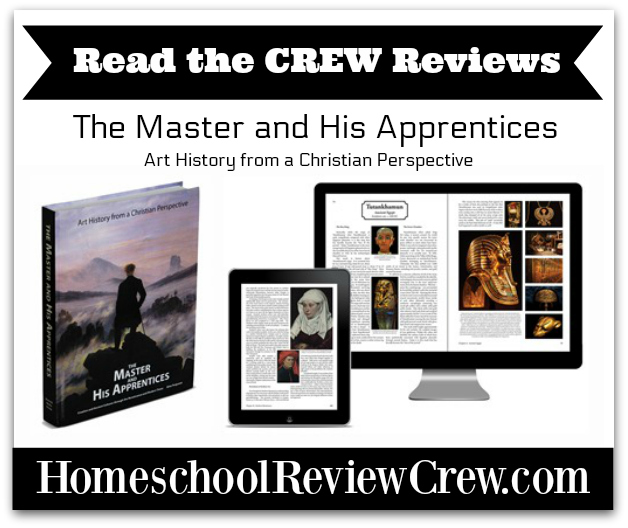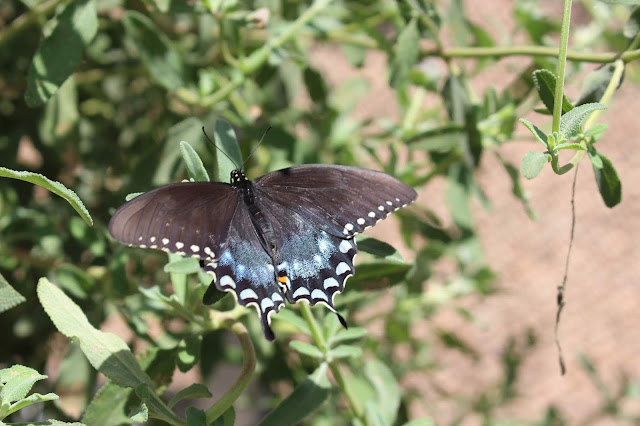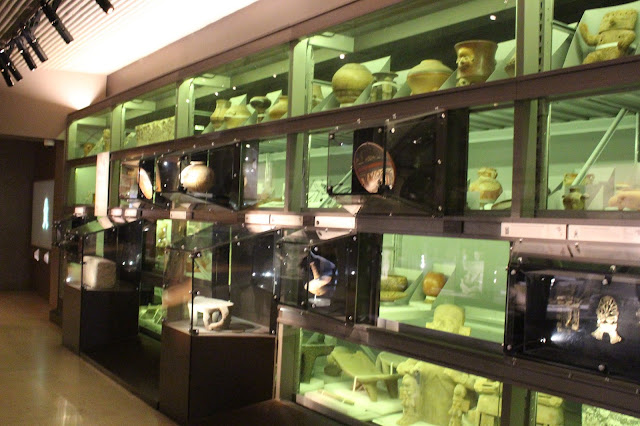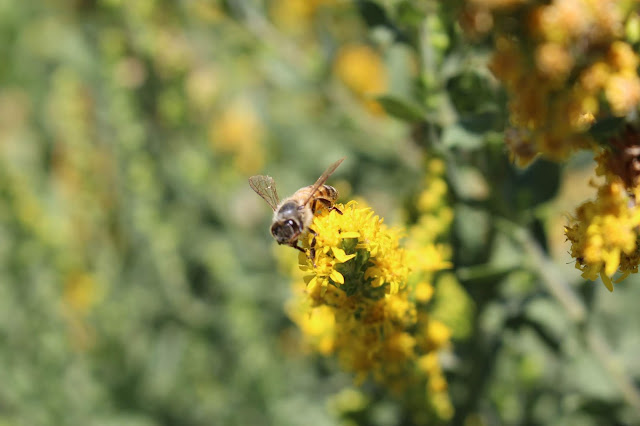One of the things that I really enjoy about being a member of the Review Crew is that sometimes there are curriculum that, while not the right age for my kids, they are something that I personally can use to enrich myself or further my own knowledge in regards to a particular topic. Today's review falls into that category.
Way back when I was in middle school, I enjoyed taking art classes as an elective. It was in those classes as a young student that I was introduced to the artistic masters like Van Gogh, da Vinci, and Michelangelo as well as more contemporary artists like Grandma Moses, Salvador Dali, Jackson Pollock and Pablo Picasso. However, as I got into high school, art classes fell to the wayside for classes that would advance me in the career field I was more interested in. Nearly 30 years later, I was given the opportunity to review the digital version of The Master and His Apprentices: Art History from a Christian Perspective, an art history curriculum from The Master and His Apprentices, I knew that while my kids were too young for the information, it would be of great interest to me.
What Is The Master and His Apprentices
Written by experienced Art History teacher Gina Ferguson, The Master and His Apprentices is a 380 page digital textbook (also available in a physical format) which teaches students to recognize God's hands being the Master Artist and providing the experience and ability to various apprentices throughout history .
The course begins with the ultimate creation, God creating the universe and all within it and then takes students on a tour through the art of ancient cultures such as Egyptian and Aegean, through the Early Greeks, Etruscan and Roman artists of the Classical Antiquity period, the various period of the Renaissance period and finally on to modern contemporary art of today. The textbook contains 19 chapters as well as an additional appendix and an index to allow for quick location of a particular artist, location, or style of work.
In addition to the textbook, members of the review crew were also given the accompanying 116 page Teacher Guide. This PDF file contained discussion questions, student worksheets, exams and other supplemental (syllabus, research paper topics, ect) that can be used in the classroom setting. (I should also mention here that purchase of the digital version of the teacher's guide allows for printing for one student - if multiple students will be using the curriculum, teachers must purchase photocopy rights for each additional student at $2/student.)
Using the two components together, The Master and His Apprentices can be used to achieve a full High School Art History credit when students complete four research papers and complete all handouts and exams. The Teacher Guide contains a full schedule to break down the curriculum into 36 1-hour per week classes divided into two 18-week semesters to fit into a standard one year program.
Unlike other art history programs, The Master and His Apprentices approaches art history from a Biblical worldview. The art work shown on the pages contains no nudity or other objectionable material and the accompanying text demonstrated how the art and the Bible line up together. With more than 600 full color photos of art work, maps, , this curriculum is a walk through not only art and artists, but history, geography, cultures, and world religions as well.
How I Used This
Since I was using this item for my own educational purposes and not for class credits, I did not focus so much on the Teacher's Guide as I would have if using it for my students. Instead, I focused mostly on the textbook itself.
After purchase of the digital format of the curriculum, buyers are given instructions on how to download and that they have 72 hours in which to download the files for both the text and the teachers guide. These files are to be saved on their computer, after which an internet connection is not necessary to view them. The Textbook is a larger file at 111MB, so depending on your internet connection, might take a long period of time in which to download. Once I had the files downloaded to my computer as well as transferred to my storage drive for safe keeping, I also sent the file to my tablet for viewing off my computer. Files are in PDF format and can be viewed with any program that can read PDF files. Files are also formatted in such a way that they can be printed out and placed in a 3 ring binder - however, I did not opt for this method as I was perfectly fine with reading it on my Kindle.
 |
| The Master and His Apprentices on my Kindle Fire Tablet |
I especially enjoyed Chapter 4 which covered Ancient Egypt, which takes readers through a tour of the history and the various ruling dynasties, as well as the different styles of pyramids that can be found there. I really was tickled looking at the treasures found in King Tutankhamen's tomb, especially since I had seen a number of those treasures in person just recently at the King Tut exhibit in Los Angeles (the canopic jar, the alabaster jar, the sun falcon necklace and the fan head).
I also really enjoyed the section on the Palace of Knossos. I mentioned in a recent art review that I had shared this section with Ashleigh when her art lesson discussed King Minos's palace and the fresco of the Leaping Bull. We had previously seen black and white photos of the inside of the palace when we read about it in an old Richard Halliburton book so we both really enjoyed looking at the stunning color photographs of the ruins of the palace together in this book. There's also a section that focuses on the various cathedrals throughout the world that we really enjoyed looking at.
In addition to revisiting things I already knew about and really liked seeing again, there has been plenty of places and people I had never of before this book. For example, I had never heard of Claus Sluter, a Proto-Renaissance sculpture from France that lived from 1340 to 1406. To be perfectly honest, I had never even heard of the Proto-Renaissance before I read about it in this book, much less Claus Sluter and his "Well of Moses" sculpture (originally called the Great Cross). I really enjoyed learning about the history of this particular piece and admiring the life like details Sluter put into his representations of important Biblical figures like King David, Moses, and Daniel. (Zachariah's beard looks like you could reach out and touch it and it would be soft and fuzzy.) I really would have liked to have seen this piece with the Crucifixion portion before it had been destroyed.
Of course, the well known masters are all represented as well. Caravaggio, Michelangelo, Donatello, Da Vinci, and Bernini (whom I originally became familiar with thanks to Dan Brown's Angels & Demons). I have really enjoyed reading about each of these, and learning more about them and their style of art. Each artist is presented as a mini-biography about their life, death, what style of art or medium they are most known for and a few of their most notable or religious pieces. Many of these, I hadn't seen before. For example, I really like Rembrandt's works but i had never seen Christ in the Storm on the Sea of Galilee in any other books before. Although, I was a bit sad to see Van Gogh and Monet lumped together in a single chapter and only a brief mention, rather than a chapter for each of them.
While my main focus was the enjoyment of the textbook and not the teachers guide (it's a bit difficult to fill out papers in the dark while lying in bed), I did find myself printing out some of the discussion questions and filling in the answers as I read along while the kids were working on their schoolwork. I found that many of the questions were not "copy from the text" style questions but instead were designed more for the student to think about what they learned and apply their knowledge of the subject. Questions were less objective and are instead more open ended, subjective style questions.
While I am thoroughly enjoying reading the text and learning on my own, I am also planning ahead for September when we will once again add Art Study to the kids schedule. With all the beautiful photographs of paintings, sculptures and even architecture, plus the very well written history behind both the artist and the artwork, I know that having this textbook in my library will make teaching the kids art history easy. It's a product that I can see us coming back to again and again, both for the educational value as an Art History credit as my kids get older as well as for the entertainment value as just extremely interesting reading material.
For more information about The Master and His Apprentices, be sure to visit their website. You can also find them on them on the following social media sites:
Facebook: https://www.facebook.com/The-Master-and-His-Apprentices-245504999349223/
Pinterest: www.pinterest.com/themasterandhisapprentices/boards/
Pinterest: www.pinterest.com/themasterandhisapprentices/boards/





































































































